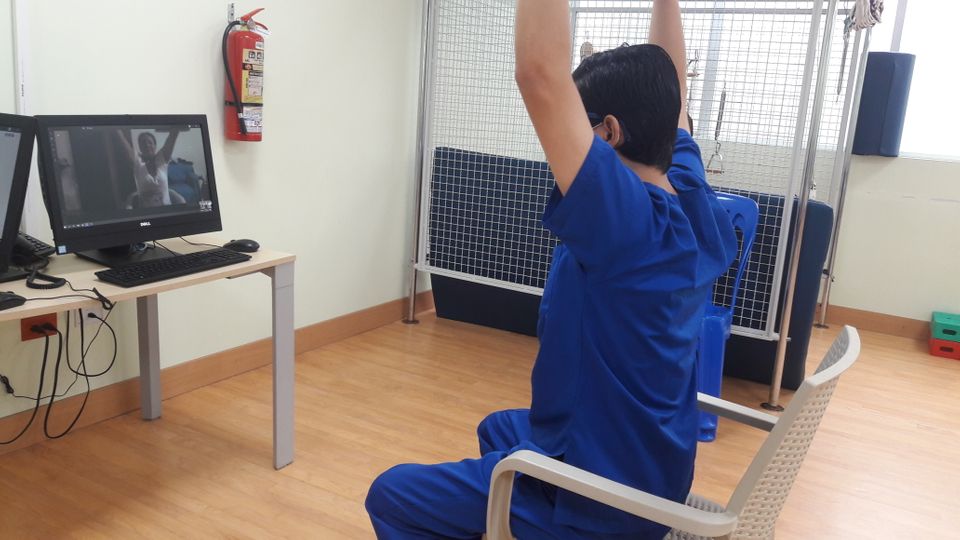Issue 24 Blue Crab Edition - HIIT for Fibromyalgia and Generic Manips Are Just As Good as Directed Ones

Before we dive in, let me offer you some Christmas / Hanukkah cheer in the form of Science Friday’s Books of the Year list. I assume you like science books and can personally vouch for Entangled Life, Black Hole Survival Guide, Ocean! Waves for All, The Great Indoors, and The Bird Way. Check them out and more over on the list. Many are available digitally through your local library (that’s where I read them all), so check that out before buying any. The SciFri links support local bookshops too. How cool!
Now, back to PT content with a new study comparing HIIT and moderate exercise for fibromyalgia and how to strength test shoulders when doing telemedicine. Let’s dive in!
If You Want to Get FIIT, HIIT May Not Be Best Actually
The Gist - Okay, that headline isn’t specifically true, this only applies to women with fibromyalgia using the Fibromyalgia Impact Questionnaire as a primary outcome, and the VAS scale for pain, the SF-36, and a cardiopulmonary exercise test as secondaries. They popped 55 people into a study, splitting them into High Intensity Interval Training (HIIT), Medium Intensity Continuous Training (MICT), and Control Groups. They did what you would expect, with HIIT doing four sets of 4 minute high intensity intervals interspersed with 3 sets of recovery and MICT doing 45 minutes of moderate exercise. Afterward, they did 15 minutes of the same strength and stretching exercises. This happened for 5 sessions/wk for 6 weeks.
Afterward, they grabbed a bunch of data and here’s what it said: MICT and HIIT were both significantly better than control across all outcome measures. Yay! MICT and HIIT tied on the Fibromyalgia scale, the SF-36, and cardiopulmonary test. MICT won on other measures, specifically doing better at body weight, fat percentage, fat mass, and body mass. Overall, HIIT and MICT were equal for fibromyalgia, and MICT was better for weight loss.
Tell Me More - Before we do too much more, let’s talk about what fibromyalgia is again, real quick. The diagnostic criteria used in the paper included a history of generalized pain in at least four regions at a similar level for at least 3 months, widespread pain index of 7 or more and symptom severity score of 5 or more OR widespread pain index of 4-6 and symptom severity score of 9 or more. In other words, you hurt all over at a high level and it sucks.
Other than that, there’s very little complexity in the study. To get specific on the training they did, the aerobic stuff was all on a cycle ergometer while the
Strengthening exercises were performed for 10 minutes, where major muscle groups were strengthened through shoulder press, dumbbell press, shoulder elevation with resistance, biceps curl, squats, hip flexion and extension, and standing hip exercises using 1-3 kg of weight loads and 1 set of 8-10 repetitions. Finally, stretching exercises were performed for 5-minutes by holding the main muscle-tendon groups for 20-30 seconds, with 4-5 repetitions for each muscle group.
The results were a bit surprising, since HIIT has been demonstrated to be more effective at building fitness and cutting fat in a myriad of studies, though not all. Lastly, the authors say that they performed the study due to the prevalence of obesity in patients with fibromyalgia, likely due to their daily pain and symptom severity. Even though it may be tough for them to get started exercising due to these factors, this research shows that they’ll probably be better off and in less pain if they can.
Here, have a paper. You’re welcome.
Just Push Anywhere - Generic Vertebral Manips are Equal to Directed Manips in Chronic LBP
The Gist - This study from the Journal of Physiotherapy assessed two different styles of vertebral manips, directed and generic. Building on previous research that showed that generic manips were equal to directed ones in one treatment, the researchers checked out how a long term treatment program with only generic manips would work. What’s a direct vs generic manipulation? A PT applied light, P-A vertebral pressure at each spinal level, and the patient told them where it was most symptomatic. In the direct manipulation group, that level was then selected for manipulation. In the generic manip group, they went through the same pain ID process, then had manips done in the mid-thoracic (T5 or T6). Patients had a total of ten treatments over the course of four weeks, then were assessed at weeks 4, 12, and 26.
Pain intensity was the primary outcome measure, and they also used a disability scale. Total, there were 148 patients in the study and the pain differences at weeks 4, 12, and 26 were all within 0.1 points, not clinically significant. Almost exactly the same! So, manips at the most painful level or mid-thoracic caused the same pain reduction and disability differences weren’t significant either.
Tell Me More - The big question you’re probably asking is “why does this matter?” The study authors assess that as well. Since there are no clinically important differences in pain, disability (according to the Roland Morris Disability Questionnaire) or Global Perceived Effect between the two techniques, it allows a PT to choose where to manip without sacrificing treatment efficacy. According to the study authors:
Based on the results of this trial, the therapist may choose his/her preferred therapy: non-specific or specific manipulation. In the case of patients with severe low back pain, for example, the therapist’s decision would be to manipulate a site away from the painful segment. Also, the therapist’s ability with either technique may be considered. Therapists may choose to manipulate the patient specifically at the most affected level or not, according to the technique in which he/she is most skilled and has the most experience.
They go a bit deeper on this analysis in the whole paper as well, so check that out if you’re looking for more reasons why it matters.
The big remaining questions are: 1) Why these techniques are the same? and 2) What are the weaknesses? The big answers are: 1) We don’t really know but we think that it’s because the lumbar and thoracic regions are interdependent, so this is like treating the thoracic spine to help with neck pain(which works, jsyk) and 2) the therapist wasn’t blinded to the technique used (because, how?). Overall, a really interesting study that opens up new avenues in treating complex patients.
Alright, where’s that paper? Right here!
Bonus Article: Believe It Or Not, You CAN Test Strength in Telemedicine
This week, we’re doing three! Just for fun. Normally, you just get two articles as a Blue Crab member, but I was feeling extra nice this week. Become a King Crab member for Four articles every week. PTCrab.org/Subscribe or get it for free through our affiliate program Grow.surf/esvria.
The Gist - Rather than from DPTs and MDs, like most of our studies, this one comes from a bundle of physicists from Saint Paul, MN. What better group of people to measure a bunch of Therabands though? That’s what they did.
They stretched a bunch of green Therabands to calibrate their equipment, then put their volunteers to work pulling them into flexion and extension. Turns out, they could come up with a normalized scale of Theraband length v force of stretch, but the volunteers inserted a new problem, arm length.
They recorded volunteers stretching Therabands and measured their arm angles via a goniometer app pointed at the screen. Volunteers with longer arms had to stretch the Theraband more to get to a given angle, so they also had to produce a higher force. Fortunately, the authors made some sweet charts that can be used to match arm length to angle and come up with the force required to get there. It’s smart stuff. Using their graphs, a measuring tape, a Goni, and a green theraband, you can measure the force of anyone’s shoulder flexion or extension via telemedicine. Just have them measure their arm length (or guess, since men average 66cm and women 59) and stretch the Theraband, then measure the angle of flexion/extension and consult the table to find the force used.
Tell Me More - This is another study without too much complexity, but I do have a bit more. The researchers wanted to make this a stand-in for MMT, but that’s tough to do since there aren’t reference values for shoulder strength and it’s not the same type of motion. Still, for comparing relative strength deficits (affected vs. unaffected), this is a well calibrated method that’s better than “lacks strength”. You can find out exactly how much strength is lacking. This (obviously) works via telemedicine but could certainly work in the clinic too.
Can I See the Graph? Indeed you can.
That’s all I’ve got today, but for one last note that you could have twice as many articles if you popped into our King Crab subscription. We’re running a sale right now as well, $45 for a full year of 4 high-quality articles per week. That’s a savings of 25%. Check it out at PTCrab.org/subscribe. I love offering Blue Crab for free, but PT Crab needs our King Crab subscribers in order to stay alive, so please consider supporting us by upgrading to the full edition. Thanks!
P.S. Remember to just hit Reply if you have any comments or questions about this edition. Cheers!
P.P.S. Happy Hanukkah!
Featured image credit: Ceibos, CC BY-SA 4.0 https://creativecommons.org/licenses/by-sa/4.0, via Wikimedia Commons






Comments
Want to leave a comment and discuss this with your fellow PTs? Join PT Crab and get summarized PT research in your inbox, every week.